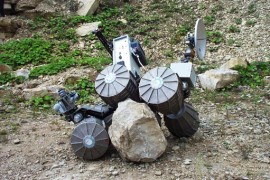Drive Selection – Wheels, tracks and more
by David Kohanbash on July 25, 2016

In the past we have looked at wheel design and the kinematics of skid steer and mecanum wheels. In this post we will take a quick look at different types of mobility types (ie. wheels, tracks, and how to connect them) for drive selection.
I know the items in this list are not direct comparisons. For example listing rocker bogie is not necessarily exclusive to other types listed. Also I know that you can design a vehicle to get around the pros and cons that I list below. The list below is based on the common mechanical configurations.
For the purpose of this post:
Holonomic motion is where a vehicle can go in all X and Y directions and is not constrained.
non-holonomic motion is where a vehicle is constrained to only certain motions. An example is a car that is not capable to drive sideways (with its ackerman steering). (Don’t yell at me about the parallel parking magical cars. They are not the norm.)

| Type | Pros | Cons |
| Tracks (Differential Drive) | Good mobility for rough terrain, low ground pressure | Complex mechanism, high power usage when turning |
| Skid Steer 4 wheel | Very simple, high weight capacity | High power usage, requires skidding/slipping |
| Differential drive 2 wheel + Passive Caster(s) | Easy | Lower weight designs, less precise controls. bad for obstacles/bumps |
| 2 wheel + 1 Powered Steering Caster | Easy mechanical, powered steering wheel for control | Lower weight designs, potentially a lot of weight on steering wheel. |
| 2 wheel (Segway Drive) | Easy mechanical, fun! | Not dynamically stable |
| Ackerman Steering | Wheels do not need to slip to turn. Fixed rear wheels makes control geometry easier. | Increased motor count |
| Rear wheel forklift steering | Tight maneuverability, good if weight is on front wheels | Less responsive than ackerman, unstable at “high” speeds |
| Independent all wheel steering | Lot of flexibility for motion | Complexity of mechanism and large number of motors. More coordination needed for turns. |
| Rocker Bogie / Body Averaging | Helps body average the chassis to minimize pitch. Allows all wheels to maintain ground contact while distributing the weight. | Mechanical complexity |
| Omni | Non-holonomic, light, simple, Best performance when traveling diagonal, number of wheels can be varied | Motion can be bumpy, sensitive to nonsmooth terrain, low torque for pushing |
| Mecanum O* | Skid steer is possible, holonomic motions, can support heavy loads | Motion can be bumpy, very sensitive to nonsmooth terrain, can be noisy, lots of parts |
| Crab Steer | Allows 4 wheel drive vehicle to translate at an angles/horizontally (holonomic motion). Often wheels can all turn in for point turns. | All 4 wheels need to be actuated to spin and turn (often with 8 motors, but can be done with less). Can be unstable on hills. |
| Legs (2,4,6,etc..) | Ease of steeping over difficult terrain | Hard, complex, high power |
| Single Ball (Ballbot) | Small size base, highly maneuverable, can change robots orientation | Hard controls, not dynamically stable, good for taller robot and not wider robots |
| Inchworming** (Peristaltic Motion) | Increased drawbar and slope climbing due to utilizing static wheels/friction | Requires extra actuation, slower than typical motion, can be high power consumption |
*Mecanum X vs O configuration is based on how the wheels are mounted. With mecanum wheels the left and right side wheels are physically different. Looking from the bottom you want an O configuration. The X configuration does not allow rotation (without fighting the rollers).

** Basic description of inchworming. Inchworming moves one set of wheels at a time to utilize static friction for increased mobility.

Another category of robots are those that dont drive on land, but need to travel in pipes. There are some additional interesting methods of locomotion for in pipe type environments.

For more examples of unusual locomotion menthods visit unusuallocomotion.com. Main image also comes from that site.
Are there other mobility options that I should have included? Leave it in the comments below.


Comments
Hey, could you please provide references for this amazing comparison that you have performed?
Hi. Is there a specific item you want a reference for? The image sources are all in the caption. Most of the information above came from my experience.
Thanks!